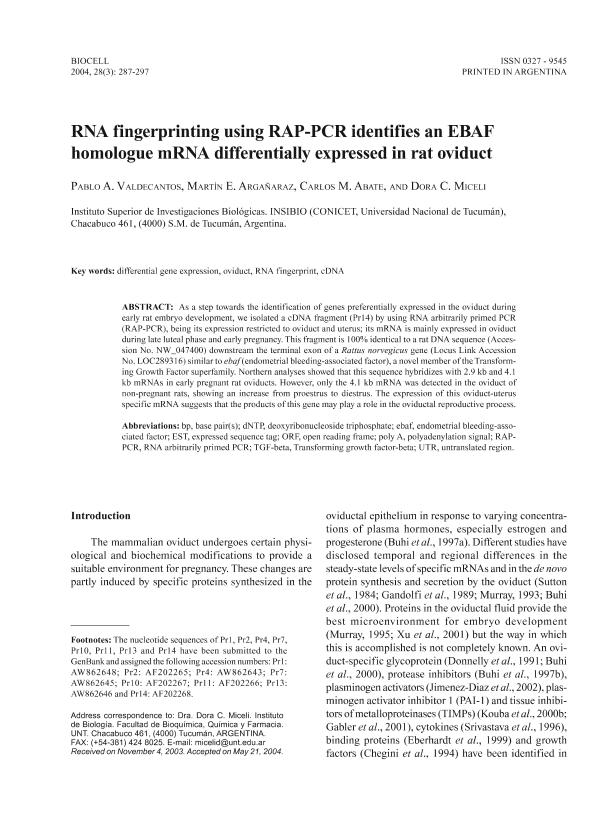Artículo
RNA fingerprinting using RAP-PCR identifies an EBAF homologue mRNA differentially expressed in rat oviduct
Valdecantos, Pablo Alberto; Argañaraz, Martin Eduardo ; Abate, Carlos Mauricio
; Abate, Carlos Mauricio ; Miceli, Dora Cristina
; Miceli, Dora Cristina
 ; Abate, Carlos Mauricio
; Abate, Carlos Mauricio ; Miceli, Dora Cristina
; Miceli, Dora Cristina
Fecha de publicación:
12/2004
Editorial:
Centro Regional de Investigaciones Científicas y Tecnológicas
Revista:
Biocell
ISSN:
0327-9545
Idioma:
Inglés
Tipo de recurso:
Artículo publicado
Clasificación temática:
Resumen
As a step towards the identification of genes preferentially expressed in the oviduct during early rat embryo development, we isolated a cDNA fragment (Pr14) by using RNA arbitrarily primed PCR (RAP-PCR), being its expression restricted to oviduct and uterus; its mRNA is mainly expressed in oviduct during late luteal phase and early pregnancy. This fragment is 100% identical to a rat DNA sequence (Accession No. NW_047400) downstream the terminal exon of a Rattus norvegicus gene (Locus Link Accession No. LOC289316) similar to ebaf (endometrial bleeding-associated factor), a novel member of the Transforming Growth Factor superfamily. Northern analyses showed that this sequence hybridizes with 2.9 kb and 4.1 kb mRNAs in early pregnant rat oviducts. However, only the 4.1 kb mRNA was detected in the oviduct of non-pregnant rats, showing an increase from proestrus to diestrus. The expression of this oviduct-uterus specific mRNA suggests that the products of this gene may play a role in the oviductal reproductive process.
Palabras clave:
Differential Gene Expression
,
Oviduct
,
Rna Fingerprint
,
Cdna
Archivos asociados
Licencia
Identificadores
Colecciones
Articulos(INSIBIO)
Articulos de INST.SUP.DE INVEST.BIOLOGICAS
Articulos de INST.SUP.DE INVEST.BIOLOGICAS
Articulos(PROIMI)
Articulos de PLANTA PILOTO DE PROC.IND.MICROBIOLOGICOS (I)
Articulos de PLANTA PILOTO DE PROC.IND.MICROBIOLOGICOS (I)
Citación
Valdecantos, Pablo Alberto; Argañaraz, Martin Eduardo; Abate, Carlos Mauricio; Miceli, Dora Cristina; RNA fingerprinting using RAP-PCR identifies an EBAF homologue mRNA differentially expressed in rat oviduct; Centro Regional de Investigaciones Científicas y Tecnológicas; Biocell; 28; 3; 12-2004; 287-297
Compartir



